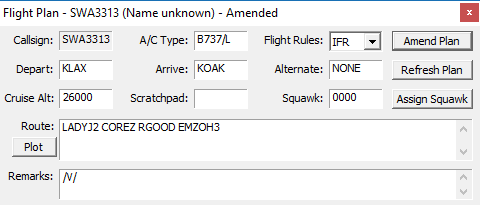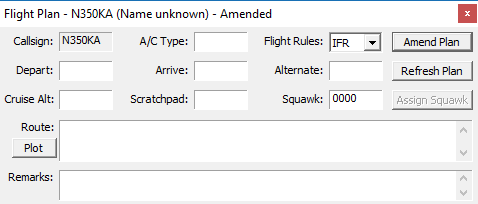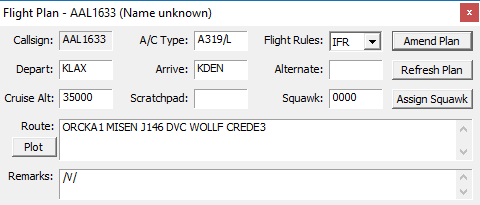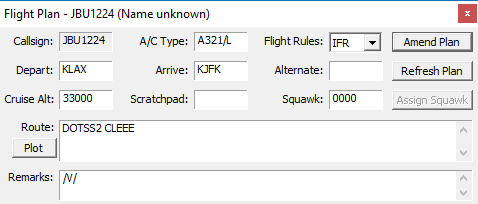

1. Directions
1. This exam tests your familiarity with standard VFR and IFR clearance phraseology, your familiarity with our SOPs, and your familiarity with our LOAs with neighboring ARTCCs. This test is "open book" and you will need at a minimum to use the documentation on the ZLA website to complete the test successfully.
2. For each question, assume that you are working SAN_DEL at noon local time and that SAN is using normal ops (runway 27) unless otherwise stated. Assume that all other airports within SCT are in normal ops as well unless otherwise stated (LAX west, BUR 8/15, SNA south, ONT west). Also assume that airports in our neighboring facilities covered by LOAs are in their normal operations (SFO west, OAK west, SJC west) unless otherwise stated. There will be a few questions based on other airports, those will be indicated in the flight plan included with the question or in the question itself.
3. For Each Question, if you are taking the text version, write the clearance you would issue word-for-word as you would speak it on voice. This includes all pronounceable items, such as callsigns, airport names, names of certain departure procedures, departure frequencies, and navaids. Names of Fixes and unpronounceable departure procedures are not subject to this rule. For example, writing "N887SP" will be marked incorrect, while "November Eight Eight Seven Sierra Papa" is correct. Writing "VNY3 departure" is incorrect because the VNY3 departure is pronounced "Van Nuys Three", but the writing the ELMOO8 Departure as "ELMOO Eight Departure" is perfectly acceptable. Do not use abbreviations, such as "c/m 5000" or "dep. freq 124.5."
4. You can assume that the pilot has all charts and can comply with any clearance you provide, unless the question states otherwise. This includes questions that state that the pilot has no departure or arrival charts. There is no need to "ask" the pilot if he can comply.
5. You must use acceptable phraseology from the 7110.65.
6. This test is not timed and doesn't have to be finished in a single session. When you start the exam, you will be presented with one question at a time. After you have typed your answer, select the "Save" button, which will save your answer and advance you to the next question. DO NOT PRESS THE SUBMIT BUTTON until you have completed all the questions. You can edit any of your answers, and you can also stop at any time and return to this exam at a later time by selecting the "ZLA Exam Center" link on the nav bar to the left. Once you have selected the "Submit" button you will no longer be able to change the answers.
7. The test will be graded by a member of the training staff and will be returned to you with a score and any comments the grader provides. The minimum score to pass the test is 80%.
8. This test will be somewhat time-consuming, especially if you have not done much studying of our procedures. If you can't seem to find an acceptable answer to a question, please send a private message to a member of the training staff. They won't be able to tell you the answer but should be able to help point you in the right direction.
2. Examples
Here are some sample questions and answers that will give you an idea of what we are looking for. The examples will use LAX, instead of SAN, however.
1. A pilot calls up with this flight plan, requesting clearance to Oakland:

Answer:
Looking at the flight plan, we see that the aircraft is filed to Oakland International Airport, which lies in ZOA's airspace. We do have an LOA with Oakland that includes a routing to OAK. As the directions of the test state, we can assume that OAK is in its normal configuration or west ops. Referencing the LOA, we can see that during west ops aircraft are to be routed via either the PXN STAR, or the EMZOH STAR. Looking at their flight plan, they are filed via the EMZOH STAR, so their routing is correct. Notice that the EMZOH STAR requires aircraft cross EMZOH at or above FL280. Consequently, we must amend their cruise altitude in the clearance. The LADYJ2 departure is not current, so will assign the LADYJ4 departure. We can amend it because the test assumes the pilot can comply. Looking at the LADYJ4 departure, we can see that it is a SID with published altitude restrictions and also contains a top altitude, so we can use "climb via SID" phraseology. For the correct initial altitude, we can reference the ZLA Initial Altitude Assignments SOP. For LAX, it states that during west operations, aircraft on a SID should be issued a restriction of "climb via SID except maintain 5000." To determine the departure frequency, we can simply reference the TRACON diagram, which lists LAX_DEP as being on 124.3. The rest of their flight plan looks great, so we can issue the clearance with the amended cruising altitude.
"Southwest thirty-three-thirteen, LA clearance, cleared to Oakland International Airport, LADYJ four departure, COREZ transition, then as filed. Climb via SID except maintain five thousand. Expect flight level two eight zero five minutes after departure. Departure frequency one two four point three. Squawk seven one six three"
2. This Pilot Calls for tower enroute to French Valley airport advises that his aircraft type is a Beech King Air 350.

Answer:
Although this aircraft does not have a flight plan on file, remember that aircraft requesting tower enroute to an airport do not need a flight plan on file to receive clearance. Looking at the ZLA Info Tool, we can determine that French Valley's airport code is F70, and that a King Air 350 is an M-class aircraft. Using this information, we can search for TEC routes between LAX and F70 in the ZLA Info Tool or on the ZLA TEC Routes page on the ZLA website and find the appropriate one for an M class aircraft. In this case, the LAXP39 TEC route is correct. The M=50 of the route means that the cruising altitude is 5000. Referencing the SLI8 departure chart, we can determine that the departure is radar vectored, however, it contains a published crossing restriction prior to the radar vectored segment, so we will still use "climb via SID" phraseology. Once again, consulting the Initial Altitude Assignments SOP, during west ops we shall use "climb via SID except maintain 5000" for the initial altitude. As 5000 is the final cruising altitude of the TEC route, we do not need to tell an aircraft to expect their final cruising altitude 5 minutes after departure. We now have the required information to issue this clearance. Because this pilot requested tower en route specifically, we can use the TEC Code in our clearance. Otherwise, we could still issue a clearance but would have to provide a full route clearance.
"King Air three five zero kilo alpha, Los Angeles Clearance, cleared to French Valley Airport, Seal Beach Eight departure, Seal Beach transition, Victor Eight, Paradise to join the Paradise Zero-Niner-Two radial, JESEX, Direct. Climb via SID except maintain five thousand. Departure frequency one two four point three. Squawk seven one seven two."
3. This Pilot Calls for Clearance. Denver is in North Operations.

Answer:
Initially, this route looks correct. However, a look at the ORCKA departure chart shows that the MISEN transition may not be the best transition for this routing. Going through our LOA with the Denver ARTCC shows that aircraft routed via DVC, should be issued WUNZE after DVC and the TBARR arrival instead of the CREDE3 arrival. This is a quick fix, and everything else in this flight plan looks fine, so we can give the clearance.
"American sixteen thirty-three, Los Angeles Clearance, cleared to Denver International Airport. ORCKA(X) departure, Las Vegas transition, Jay one forty-six, Dove Creek, direct WUNZE, TBARR(X) arrival. Climb via SID except maintain five thousand. Departure frequency one two four point three. Squawk seven one two two."
4. This Pilot Calls for Clearance.

Answer:
Although this route just feels wrong (direct after CLEEE of course isn't preferred), we have no letter of agreement with ZNY (New York), and the routing does comply with our rules. So, we can go ahead with the clearance.
"Jetblue twelve twenty-four, LA clearance, cleared to John F Kennedy International Airport, DOTSS two departure, CLEEE Transition, then as filed. Climb via SID except maintain five thousand, departure frequency one two four point three, Squawk seven zero zero five".
3. A Final Word
This test will probably be one of the more time-consuming things that you've done since joining VATSIM. At the end of it, however, you'll be well on your way to earning the ZLA Ground/Delivery Solo Rating, and your S1 promotion. Although it is a significant investment of your time now, having a solid understanding of the fundamentals and thought that goes into the clearance delivery process will be of great help to your VATSIM controlling career. Take your time, remember that you can save and come back to the test as necessary, and make sure to hit the save answer button before you move onto the next question.
Above all, this test is a learning experience. It is far more important that you demonstrate you comprehend the material than getting every little detail correct. It is graded by hand, not a machine, so there is some discretion in how your test is graded.
Good luck, and feel free to ask the training staff any questions that you may have concerning the test; we won't give you the answer, but we'll be sure to point you in the right direction.
This study guide was originally written by Eric Stearns